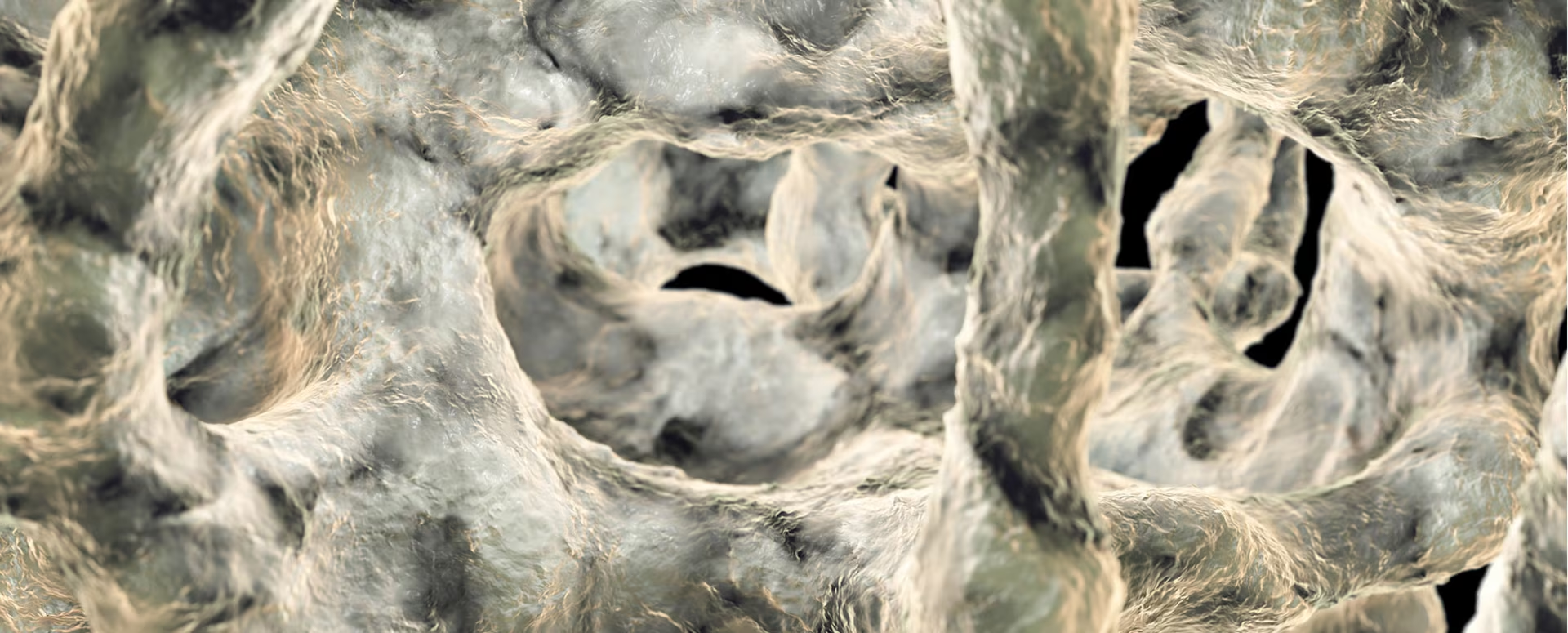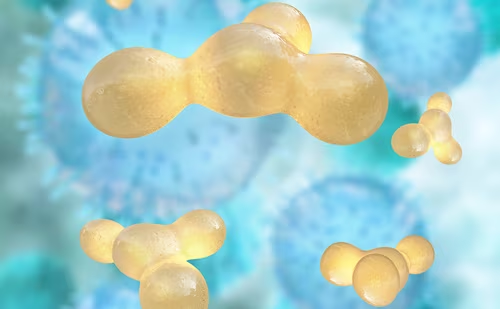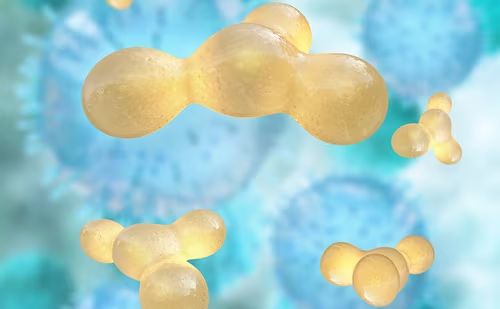Calcitonin is a polypeptide hormone produced by the thyroid gland, and regulates plasma calcium concentration. Calcitonin inhibits the activity of osteoclasts by binding to osteoclast receptors. The net result is an increase in bone mass density (BMD). Calcitonin is US Food and Drug Administration (FDA)-approved for the treatment of postmenopausal osteoporosis in women greater than five years postmenopausal and is available as both an injectable and nasal spray formulation.The nasal spray is the preferred delivery method of choice despite its lesser bioavailability.
Calcitonin is a polypeptide hormone produced by the thyroid gland, and regulates plasma calcium concentration. Calcitonin inhibits the activity of osteoclasts by binding to osteoclast receptors. The net result is an increase in bone mass density (BMD). Calcitonin is US Food and Drug Administration (FDA)-approved for the treatment of postmenopausal osteoporosis in women greater than five years postmenopausal and is available as both an injectable and nasal spray formulation.The nasal spray is the preferred delivery method of choice despite its lesser bioavailability. Calcitonin can cause the side effects of nausea and flushing, but these are usually mild and severity is dose-dependent.
Effecton BMD
There are 12 published randomized clinical trials on the efficacy of nasal calcitonin on bone mineral density (BMD), of which six are in women over the age of 55.
The PROOF (Prevent Recurrence Of Osteoporotic Fracture) study was a large five-year multicenter double blind randomized trial that began in 1991 and studied the efficacy of nasal spray salmon calcitonin in patients with 1–5 prior vertebral fractures and low vertebral bone mass. Of the original 1,255 postmenopausal women, mean age 68, who were randomized by investigators in both the US and UK, 817 had 1–5 prevalent vertebral fractures and had follow-up thoracic and lumbar spine radiographs. Patients were randomized to placebo nasal spray or one of three doses of nasal calcitonin daily: 100, 200 or 400 IU. All patients received supplements of 1,000mg elemental calcium carbonate and 400 IU vitamin D daily plus usual dietary calcium for a mean total calcium intake of 1,800mg. Baseline variables were similar across each of the four arms. Lumbar vertebral bone density increased 1.2% in the 200 IU group in the first year, which was significantly different than control at one year.There was no further increase in lumbar BMD after one year.There was a mean reduction in serum C telopeptide (CTX) from baseline of 25% at 12 months, which was sustained at 20% throughout the five years in both the 200 IU group and 400 IU group.
Effect of Nasal Calcitoninon Fracture
There are two studies of the effect of nasal calcitonin on fracture. Overgaard found that nasal calcitonin significantly reduced the rate of vertebral fractures in 124 women mean age 70, over two years (p=0.017) using pooled data (50 IU, 100 IU, 200 IU) compared with placebo. In the PROOF trial, using an intent-to-treat analysis of all randomized patients with 1–5 prevalent vertebral fractures at baseline who had follow-up thoracic and lumbar spine radiographs, there was a significant 36% vertebral fracture reduction seen in the 200 IU group compared with placebo, with a 45% reduction in the number of patients with multiple new vertebral fractures. These reductions were seen only in the 200 IU group, and not in the 400 IU group. If all patients with follow-up X-rays were included in the analysis (including patients with or without prevalent fracture) then there was a significant 33% reduction (p=0.03) in the risk of vertebral fracture. Significant vertebral fracture reduction was seen with the 200 IU dose by year three and sustained through year five. In PROOF there was no significant reduction in non-vertebral fracture; however, the PROOF study was not powered to detect non-vertebral fracture reduction.
Limitations of the PROOF Study include a high discontinuation rate and the absence of a dose response curve.The discontinuation rate of 59% for the five years of the study was higher than expected. A dose response curve of nasal calcitonin with regards to fracture reduction was not seen. Although there was significant reduction in serum CTX and a significant increase in lumbar spine BMD compared with the control group in years one and two in the 400 IU group, there was no significant fracture reduction in the 400 IU group. However a valid completer analysis at three years has shown similar fracture reduction in the 400 IU group.
Fracture Efficacy in Older Women
A post hoc stratification analysis of PROOF has been done in elderly women. In this analysis, nasal spray calcitonin reduced risk of new vertebral fracture by 53% in women over age 70 and by 62% in women over age 75. Nasal calcitonin was well tolerated in these elderly women with the only major side effect being rhinitis. Data from the PROOF trial suggest therapeutic benefit of nasal spray calcitonin compared to placebo in older postmenopausal women (>age 70) with osteoporosis, with particular and perhaps preferential benefit for older women greater than age 70 at the lumbar spine. Such findings may be of clinical importance in considering choice of a therapeutic agent for elderly women with osteoporosis.
Nasal Calcitoninon Bone Markers
Nasal calcitonin modestly reduces both urine and serum markers of bone turnover within 4–8 weeks. After cessation of treatment all biochemical markers of bone turnover return to baseline over a subsequent 12 week period. It has been suggested that patients with a higher bone turnover may have a greater response to injectable calcitonin in terms of BMD. In PROOF, patients with higher levels of bone turnover had the greatest response to treatment in terms of bone marker reduction although all patients responded to nasal spray calcitonin in terms of fracture efficacy irrespective of tertiles of baseline bone markers (urine N telopeptide, serum alkaline phosphatase or osteocalcin). Analgesic Effects
Calcitonin is unique among osteoporosis therapies in that it may have analgesic efficacy as well as vertebral fracture efficacy. Salmon calcitonin binding sites have been found in the human CNS using 125I labelled salmon calcitonin. Intramuscular or nasal salmon calcitonin has been proven to be analgesic for both the acute pain of vertebral fracture, and the chronic pain after vertebral fracture.The analgesic effect of salmon calcitonin was noted at one week or less by VAS pain and by a decrease in analgesic consumption by day three. Increased mobilization was noted by week one. Fifty IUs of salmon calcitonin IM is equivalent to 200 IU nasal spray in regard to of analgesic efficacy. Salmon calcitonin therefore may have a potential role in reducing the pain of acute vertebral fracture, reducing analgesic dependence and possibly secondarily decreasing immobilization.
Resistance and Non – responders
Calcitonin is a biological agent for osteoporosis and as such concerns have been raised about the potential for clinical resistance due to presence of neutralizing antibodies.Clinical resistance due to antibodies was not shown in PROOF. In one study about 20% of patients using calcitonin nasal spray were nonresponders in terms of lumbar spine BMD compared with baseline.The best way to identify patients who are nonresponders is not known.
Use in Males
Although not FDA approved for use in males at risk of osteoporotic fracture, studies have shown the potential efficacy of calcitonin.
Combination Therapy
There is little data on the combination of calcitonin and other anti-resorptives or anabolic agents for osteoporosis. The combination of calcitonin and bisphosphonates has no basis; they are neither synergistic or additive. New Formu lations
Oral calcitonin has shown to be effective in reducing biomarkers of bone turnover in a three-month trial. These results need to be confirmed in trials of longer duration with fracture efficacy as the end-point.
Summary
Calcitonin is FDA approved for the treatment but not prevention of postmenopausal osteoporosis. The preferred delivery system is nasal spray. An oral formulation is in development. Calcitonin reduces vertebral fracture risk similar to other anti-resorptive agents, but has not been demonstrated to reduce nonvertebral or hip fracture risk. Calcitonin produces small increments in bone mass of the spine and modestly reduces bone turnover. Calcitonin may have a possible analgesic effect for women with acutely painful vertebral fractures.Treatment with calcitonin should be considered for late postmenopausal women with osteoporosis with painful vertebral fractures or for the late postmenopausal woman with vertebral greater than hip osteoporosis. Calcitonin should be considered for the late postmenopausal woman who is unable to take oral bisphosphonates due to gastrointestinal (GI) intolerance or due to impaired renal function.







